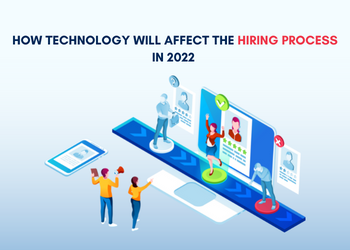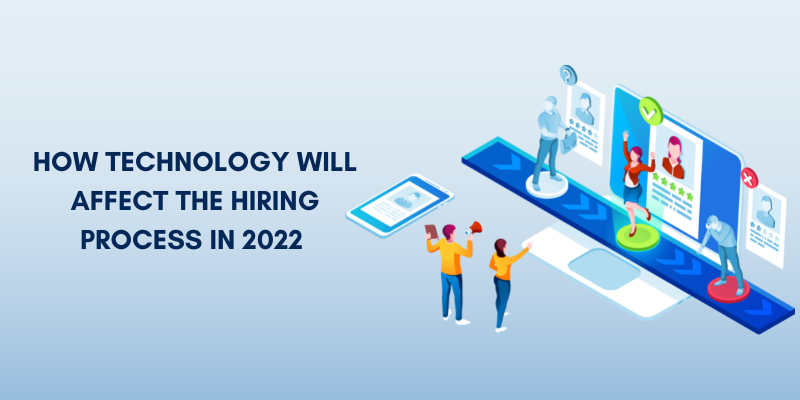How Technology Will Affect the Hiring Process in 2022

Technology is changing how businesses evaluate job candidates based on professional skills, and experience is no longer the only consideration.
Remember when experience dominated a resume? Candidates with years of professional experience saw their resumes rise to the top of the stack.
The hiring process has evolved into a skill acquisition analysis. And the emphasis is no longer on how many years of experience a job candidate has.
When it comes to having what it takes to qualify for a job, it is more about quality than quantity. Quality means learning the skills required to succeed on the job. The number of years of experience is referred to as quantity.
The shift to using skill-based talent assessment tools casts an unflattering light on a difficulty that an increasing number of employers are confronted with.
According to a Gartner research study, only 16% of new hires have all of the skills required to succeed in their current and future professional roles. It’s no surprise that 58% of recruiters say the most difficult hiring challenge is a lack of qualified candidates.
Skill acquisition has become a top priority for job seekers in all industries.
The Impact of Technology on the Hiring Process
Many aspects of our lives have been dramatically altered by technology. That change has a significant impact on the hiring process for employers. Consider new online job platforms like Indeed and Glassdoor. Employment portals have emerged as a one-stop shop for employers to screen applicants. Employers define the screening criteria, which often include digital talent assessment tools.
With technology already playing a significant role in every aspect of the hiring process, it is no longer whether it will change the landscape but how. What does the dramatic shift in the hiring process mean for job seekers and staffing firms?
The Hiring Process Is Being Changed By Social Media.
Regarding recruitment, social media is not a new kid on the block. Still, it is now being used more than ever for everything from brand awareness and promoting job opportunities to actively advertising roles and seeking candidates, and even screening and interacting with job seekers directly.
As an example, consider LinkedIn. It has been around since 2002 and has nearly 660 million users worldwide, making it the world’s largest professional network. It stands to reason that 90% of recruiters use LinkedIn in some capacity regularly, with the social media platform reporting that more than three-quarters of people who recently changed jobs used LinkedIn to inform their career decision.
While LinkedIn remains the most popular social media platform for job seekers and talent scouts, other networks are gaining traction. Instagram has grown in popularity as a platform for businesses to show the “behind the scenes” of their offices and workplaces. At the same time, Facebook’s paid advertising continues to attract people to specific roles and pages.
If you’re a candidate, think about cleaning up your social media presence by limiting the visibility of any content you don’t want a potential employer to see and connecting with organizations you’d be interested in working with. You never know when a LinkedIn connection request or an Instagram direct message will lead to a new job!
Digital Interviews
Virtual interviews are heralded as the future of recruiting and hiring, and they certainly have advantages. It can save time and make the interview process more accessible by limiting bias and removing the need for all interested parties to be physically present simultaneously. It’s ideal for initial questionnaires, one-way videos, or screening calls, which hiring managers can assess before offering an in-person interview.
However, while advanced technologies have made digital interviewing more seamless and less awkward than in the past, there are still limitations to its use in the modern hiring world.
Many employers still prefer to meet candidates in person before making any offer, as things like body language and nonverbal cues are challenging to capture on video. Candidates also prefer to visit their prospective new offices in person to get a sense of the environment and team dynamics. As a result, we believe that while digital interviewing will continue to play a role in the hiring process, it will not completely replace the functions of the recruiter or hiring manager.
Artificial Intelligence Is Becoming More Visible
More businesses are considering incorporating AI into their hiring processes, and the technology has undeniable benefits. One of the most intriguing aspects of it is that it is free of the unconscious bias humans have, allowing it to evaluate candidates solely on their responses and data.
This is also a weakness, as robots will never be able to detect human characteristics in the same way recruiters and hiring managers can. AI can help to streamline and automate repetitive, high-volume recruitment tasks, such as using machine learning to auto-screen candidates and eliminate those who do not meet essential criteria, freeing up human talent to focus on tasks like interviewing, writing job ads, and networking with potential candidates.
As a result, the future of AI in the hiring process is likely to be one in which robotics are used alongside human recruiters and managers to supplement rather than replace their existing roles. This means that a sophisticated program may automatically screen candidates before being contacted by a (human) professional, giving them the best of both worlds.
Technology Allows For Faster Recruitment Time.
We’ve previously reported that it takes an average of 47 days to fill a sales vacancy, which is far too long when you consider the high costs of recruiting, the time it takes to get a new hire up to speed, and the stress it puts on candidates waiting for a job offer.
New technologies should help to shorten this time to hire and ensure that people are placed quickly and efficiently. Whether it’s more digitalized screening methods, the use of social media to attract new candidates, virtual interviewing, or online psychometric testing, new systems and technologies will undoubtedly aid in making the hiring process – and the recruitment world – more streamlined and efficient.
How to use these technologies to your advantage
As a result, technological advancements have improved hiring processes for industries worldwide. But how do you begin to transform your current recruitment strategy into a new, digitally-savvy one?
Step 1. Understand your target audience
You must first assess the needs of your candidates before you can hope to target them.
- What issues are they dealing with?
- What is preventing them from applying with you?
- What do they do with their free time?
- What type of messaging works best for them?
- Why are they remaining in their current position?
Step 2: Develop your digital strategy.
Numerous platforms help employers collect candidate data, review applications, target top talent, and manage experiences. Create a digital recruitment strategy to determine which will be most beneficial to your company. Examine recruitment data, identify improvement areas, and then purchase appropriate software.
Step 3: Put technology to use
Consider your digital strategy and use technology to reach your audience the next time you need to fill a gap in your company. A multi-platform approach is the most effective.
Maintain open communication lines with prospective candidates and keep them updated as you make your hiring decision.
Step 4: Find a job with Bestarion.
It is difficult to find qualified candidates in a world with so many shortages. It is not enough to make promises; you must also follow them.
Bestarion can assist you.
We are global recruitment specialists who source employees for various dynamic job positions, hand-picking the best candidates for each client. Our commitment to locating experienced candidates with the necessary qualifications enables businesses to foster growth and scale.

